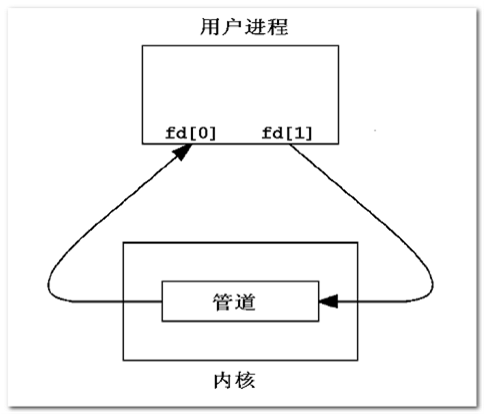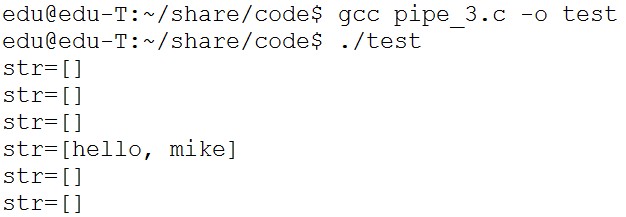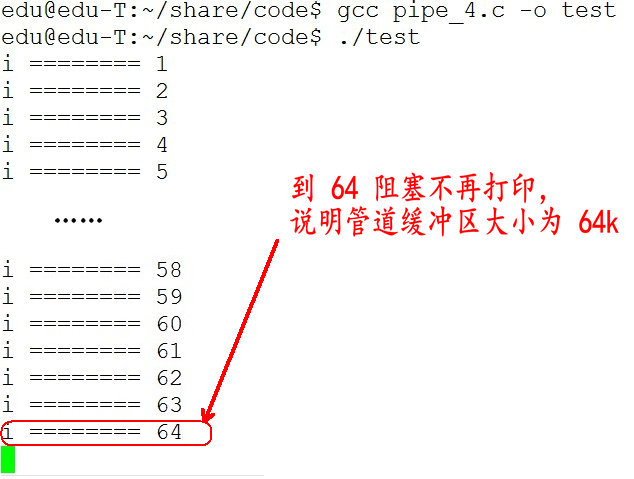管道的概述
管道也叫无名管道,它是是 UNIX 系统 IPC(进程间通信) 的最古老形式,所有的 UNIX 系统都支持这种通信机制。
无名管道有如下特点:
1、半双工,数据在同一时刻只能在一个方向上流动。
2、数据只能从管道的一端写入,从另一端读出。
3、写入管道中的数据遵循先入先出的规则。
4、管道所传送的数据是无格式的,这要求管道的读出方与写入方必须事先约定好数据的格式,如多少字节算一个消息等。
5、管道不是普通的文件,不属于某个文件系统,其只存在于内存中。
6、管道在内存中对应一个缓冲区。不同的系统其大小不一定相同。
7、从管道读数据是一次性操作,数据一旦被读走,它就从管道中被抛弃,释放空间以便写更多的数据。
8、管道没有名字,只能在具有公共祖先的进程(父进程与子进程,或者两个兄弟进程,具有亲缘关系)之间使用。
对于无名管道特点的理解,我们可以类比现实生活中管子,管子的一端塞东西,管子的另一端取东西。
无名管道是一种特殊类型的文件,在应用层体现为两个打开的文件描述符。
管道的操作
所需头文件:
#include <unistd.h>
int pipe(int filedes[2]);
功能:
创建无名管道。
参数:
filedes: 为 int 型数组的首地址,其存放了管道的文件描述符 filedes[0]、filedes[1]。
当一个管道建立时,它会创建两个文件描述符 fd[0] 和 fd[1]。其中 fd[0] 固定用于读管道,而 fd[1] 固定用于写管道。一般文件 I/O 的函数都可以用来操作管道( lseek() 除外)。
返回值:
成功:0
失败:-1
下面我们写这个一个例子,子进程通过无名管道给父进程传递一个字符串数据:
#include <stdio.h>
#include <string.h>
#include <unistd.h>
#include <stdlib.h>
#include <sys/types.h>
#include <sys/wait.h>
int main(int argc, char *argv[])
{
int fd_pipe[2] = {0};
pid_t pid;
if( pipe(fd_pipe) < 0 ){// 创建无名管道
perror("pipe");
}
pid = fork(); // 创建进程
if( pid < 0 ){ // 出错
perror("fork");
exit(-1);
}
if( pid == 0 ){ // 子进程
char buf[] = "I am mike";
// 往管道写端写数据
write(fd_pipe[1], buf, strlen(buf));
_exit(0);
}else if( pid > 0){// 父进程
wait(NULL); // 等待子进程结束,回收其资源
char str[50] = {0};
// 从管道里读数据
read(fd_pipe[0], str, sizeof(str));
printf("str=[%s]\n", str); // 打印数据
}
return 0;
}
运行结果如下:
管道的特点
每个管道只有一个页面作为缓冲区,该页面是按照环形缓冲区的方式来使用的。这种访问方式是典型的“生产者——消费者”模型。当“生产者”进程有大量的数据需要写时,而且每当写满一个页面就需要进行睡眠等待,等待“消费者”从管道中读走一些数据,为其腾出一些空间。相应的,如果管道中没有可读数据,“消费者” 进程就要睡眠等待,具体过程如下图所示:
默认的情况下,从管道中读写数据,最主要的特点就是阻塞问题(这一特点应该记住),当管道里没有数据,另一个进程默认用 read() 函数从管道中读数据是阻塞的。
测试代码如下:
#include <stdio.h>
#include <string.h>
#include <unistd.h>
#include <stdlib.h>
#include <sys/types.h>
#include <sys/wait.h>
int main(int argc, char *argv[])
{
int fd_pipe[2] = {0};
pid_t pid;
if( pipe(fd_pipe) < 0 ){// 创建无名管道
perror("pipe");
}
pid = fork(); // 创建进程
if( pid < 0 ){ // 出错
perror("fork");
exit(-1);
}
if( pid == 0 ){ // 子进程
_exit(0);
}else if( pid > 0){// 父进程
wait(NULL); // 等待子进程结束,回收其资源
char str[50] = {0};
printf("before read\n");
// 从管道里读数据,如果管道没有数据, read()会阻塞
read(fd_pipe[0], str, sizeof(str));
printf("after read\n");
printf("str=[%s]\n", str); // 打印数据
}
return 0;
}
运行结果如下:
当然,我们编程时可通过 fcntl() 函数设置文件的阻塞特性。
设置为阻塞:fcntl(fd, F_SETFL, 0);
设置为非阻塞:fcntl(fd, F_SETFL, O_NONBLOCK);
测试代码如下:
#include <stdio.h>
#include <string.h>
#include <unistd.h>
#include <stdlib.h>
#include <sys/types.h>
#include <sys/wait.h>
#include <fcntl.h>
int main(int argc, char *argv[])
{
int fd_pipe[2] = {0};
pid_t pid;
if( pipe(fd_pipe) < 0 ){// 创建无名管道
perror("pipe");
}
pid = fork(); // 创建进程
if( pid < 0 ){ // 出错
perror("fork");
exit(-1);
}
if( pid == 0 ){ // 子进程
sleep(3);
char buf[] = "hello, mike";
write(fd_pipe[1], buf, strlen(buf)); // 写数据
_exit(0);
}else if( pid > 0){// 父进程
fcntl(fd_pipe[0], F_SETFL, O_NONBLOCK); // 非阻塞
//fcntl(fd_pipe[0], F_SETFL, 0); // 阻塞
while(1){
char str[50] = {0};
read( fd_pipe[0], str, sizeof(str) );//读数据
printf("str=[%s]\n", str);
sleep(1);
}
}
return 0;
}
运行结果如下:
默认的情况下,从管道中读写数据,还有如下特点(知道有这么回事就够了,不用刻意去记这些特点):
1)调用 write() 函数向管道里写数据,当缓冲区已满时 write() 也会阻塞。
测试代码如下:
#include <stdio.h>
#include <string.h>
#include <unistd.h>
#include <stdlib.h>
#include <sys/types.h>
#include <sys/wait.h>
int main(int argc, char *argv[])
{
int fd_pipe[2] = {0};
pid_t pid;
char buf[1024] = {0};
memset(buf, 'a', sizeof(buf)); // 往管道写的内容
int i = 0;
if( pipe(fd_pipe) < 0 ){// 创建无名管道
perror("pipe");
}
pid = fork(); // 创建进程
if( pid < 0 ){ // 出错
perror("fork");
exit(-1);
}
if( pid == 0 ){ // 子进程
while(1){
write(fd_pipe[1], buf, sizeof(buf));
i++;
printf("i ======== %d\n", i);
}
_exit(0);
}else if( pid > 0){// 父进程
wait(NULL); // 等待子进程结束,回收其资源
}
return 0;
}
运行结果如下:
2)通信过程中,别的进程先结束后,当前进程读端口关闭后,向管道内写数据时,write() 所在进程会(收到 SIGPIPE 信号)退出,收到 SIGPIPE 默认动作为中断当前进程。
测试代码如下:
#include <stdio.h>
#include <string.h>
#include <unistd.h>
#include <stdlib.h>
#include <sys/types.h>
#include <sys/wait.h>
int main(int argc, char *argv[])
{
int fd_pipe[2] = {0};
pid_t pid;
if( pipe(fd_pipe) < 0 ){// 创建无名管道
perror("pipe");
}
pid = fork(); // 创建进程
if( pid < 0 ){ // 出错
perror("fork");
exit(-1);
}
if( pid == 0 ){ // 子进程
//close(fd_pipe[0]);
_exit(0);
}else if( pid > 0 ){// 父进程
wait(NULL); // 等待子进程结束,回收其资源
close(fd_pipe[0]); // 当前进程读端口关闭
char buf[50] = "12345";
// 当前进程读端口关闭
// write()会收到 SIGPIPE 信号,默认动作为中断当前进程
write(fd_pipe[1], buf, strlen(buf));
while(1); // 阻塞
}
return 0;
}
运行结果如下:
---------------------
作者:Mike__Jiang
来源:CSDN
原文:https://blog.csdn.net/tennysonsky/article/details/46315517
版权声明:本文为博主原创文章,转载请附上博文链接!






